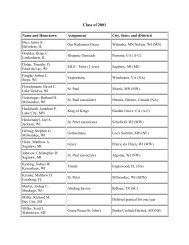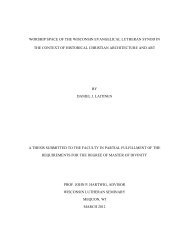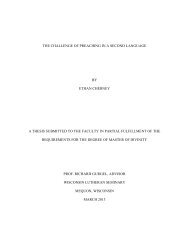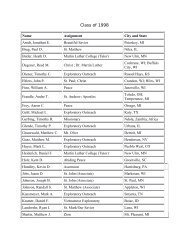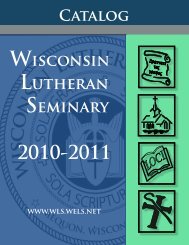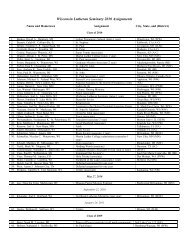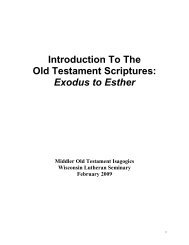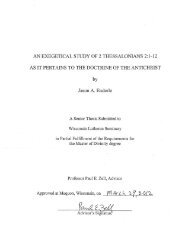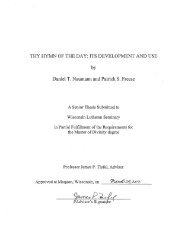Untitled - Wisconsin Lutheran Seminary - WELS
Untitled - Wisconsin Lutheran Seminary - WELS
Untitled - Wisconsin Lutheran Seminary - WELS
Create successful ePaper yourself
Turn your PDF publications into a flip-book with our unique Google optimized e-Paper software.
Gordon Fee takes a different position based on the idea of the parallelism of Hebrew<br />
poetry. 85 He says,<br />
At the same time, the poetic nature of this sentence seems to disallow altogether that<br />
these two lines of (now poetic) prose intend two different events. Indeed, it is the nature<br />
of such synonymous parallelism in Hebrew poetry that the second line usually simply<br />
86<br />
elaborates or intensifies what is said in the first line.<br />
While the parallelism of Hebrew poetry is something to recognize, one cannot necessarily make<br />
such conclusions with Paul’s words here. When one looks at Isaiah 11:4, the first phrase is<br />
indeed intensified with the second. The subjects of both phrases, however, are similar: “the rod<br />
of his mouth” and “the breath of his lips.” Here the subjects are two different aspects of the Lord<br />
Jesus; first, the breath of his mouth, and second, the appearance of his coming. This seems to<br />
imply two different actions or events. When these events will take place and how much time<br />
will be between them is unknown. Paul does not want to raise different concerns with the<br />
Thessalonians by causing them to fear this great evil force. There will be no question as to what<br />
will be the outcome. The Lord Jesus will stand victorious over the clearly defeated “lawless<br />
one.”<br />
The Lord will abolish him “with the appearance of his coming” (τῇ ἐπιφανείᾳ τῆς<br />
παρουσίας αὐτοῦ). ἐπιφάνεια (“appearance”) is a rather rare noun in the New Testament. Outside<br />
of this letter, it only appears five other times, all in Paul’s pastoral epistles. Paul uses it once in 2<br />
Timothy 1:10 to refer to the first appearance of Christ on this earth at his birth. The other four<br />
references (1 Ti 6:14; 2 Ti 4:1,8; Tit 2:13) all refer to his appearance in judgment as he returns in<br />
glory, much similar to the use here. D. Michael Martin suggests, “The term implies a visible<br />
demonstration of the presence of a formerly unseen deity. It may consist of a revelation of the<br />
deity himself or a revelation of his power through some visible act.” 87<br />
85 Other commentators see this sentence as parallelism to describe the same action: Hendriksen (183),<br />
Ward (160), and Martin (243).<br />
86 Gordon D. Fee, The First and Second Letters to the Thessalonians (Grand Rapids, MI: Wm. B.<br />
Eerdmans Publishing Co., 2009), 292.<br />
87 D. Michael Martin, 1, 2 Thessalonians. Vol. 33, The New American Commentary (Broadman & Holman<br />
Publishers, 1995), 242.<br />
42




